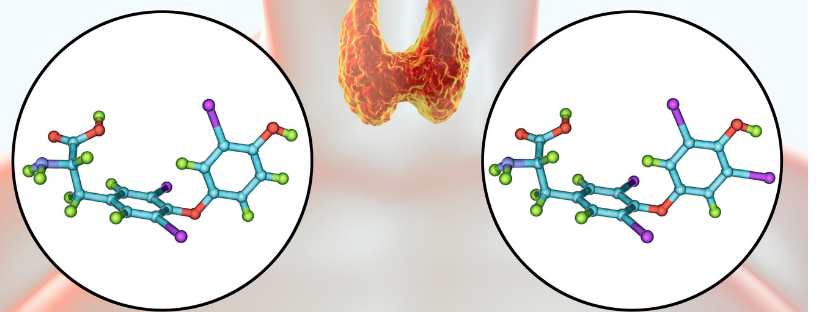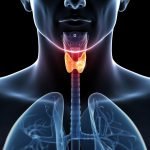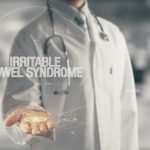Sarah A. LoBisco, ND
Hashimoto’s thyroiditis (HT) is the leading cause of hypothyroidism in the United States.1 It is one of the most common organ-specific autoimmune disorders of the thyroid, among Graves’ disease, trophic thyroiditis, primary myxedema, and postpartum thyroiditis. HT has characteristic features of lymphocytic infiltration along with the presence of serum anti-thyroperoxidase antibody (TPOAb) and/or anti-thyroglobulin antibody (TgAb).2
The symptoms of a clinical hypothyroidism picture in HT are variable for a few reasons. First, there exists individual variance in thyroid gland destruction and disease manifestations. One study found that approximately 90% of the thyroid must be destroyed in order for the disease to display symptoms of hypothyroidism.3
In addition to gland destruction, the difference in circulating antibodies present is also a factor in HT symptomatology. There is a correlation between an increase in serum antibodies and development from a euthyroid to hypothyroid state. However, the rate at which those who progress to overt hypothyroidism is not dependent on specific levels or ranges of antibodies present.3,4
Some studies have suggested that TPOAb, an immunoglobulin G (IgG), which is found in about 95% of cases of HT, is the result of an injury.3,5 All 4 subclasses of IgG have been found in HT, with each subclass responsible for different biological functions. Therefore, studies on the IgG subclass distribution of TPOAb might provide clues to the mechanism of symptomatology expression in HT. For example, when a 2008 study compared the different subtypes of IgG in HT, the results indicated that IgG2 and IgG4 subclasses were highest in those with subclinical and clinical hypothyroidism as compared to the euthryoid patients.3
This lack of correlation between individuals, antibody levels, and disease manifestation is not limited to HT. Other autoimmune disorders have been studied in relation to the amount of antibodies present and disease manifestations.6 According to the 2003 New England Journal of Medicine’s finding on systemic lupus erythematosus (SLE), autoantibodies were typically present many years before diagnosis.7 These findings may warrant serum autoantibody screening tests in those who carry various risk factors for HT in order to prevent complete destruction of the thyroid gland.
A final reason why the clinical hypothyroidism picture in HT varies is that those diagnosed with HT have a higher incidence of comorbid autoimmune diseases. These include celiac disease, rheumatoid arthritis, vitiligo, diabetes mellitus, Addison’s disease, and pernicious anemia.1,4,8,9
In fact, it has been stated that celiac disease1,8-11 is 5 times more common in those with HT vs. the overall population and 57% of those diagnosed with pernicious anemia have thyroid antibodies. A further study in 2007 assessed 104 patients with HT and 184 patients with celiac and concluded that the association was bi-directional.9
A study in 2001 in the American Journal of Gastroenterology stated that it was probable that 21 out of 31 hypothyroid patients were not experiencing autoimmune regulation disorders, but rather a decreased thyroid hormone synthesis related to malnutrition or iodide organification defect.12 (Iodine use has been shown in one study to suppress hyperthyroidism at the expense of hypothyroidism).13 Other studies have demonstrated how factors such as the presence of bacterial antigens and intestinal permeability issues link to HT.1,8,10,11,14 These studies provide evidence that hypothyroidism could potentially be misdiagnosed as an etiological factor of an existing immune dysfunction or vice versa.
Although the exact mechanism of the cause of HT is still unclear,3 the implications for discovering the etiology could provide useful information for prognosis. Several theories have been suggested in the pathogenesis of HT. One study showed that HT demonstrated an increase of CD8+ cells initiated by CD4+ cell activation and resulting B cells.5 Furthermore, a recent 2009 study linked the pathogenesis of HT to the presence of TgAb and its resultant monocolonal B cell proliferation. The authors of the later study concluded that this proliferation in B cells created an increased risk to the development of thyroid mucosa-associated lymphoid tissue (MALT) lymphoma.15
Genetics may also play in a role in determining the pathogenesis and mechanism of HT. Various genetic markers have been linked to HT. These markers include human leukocyte antigen class II, cytotoxic T-lymphocyte antigen 4 (CTLA-4), and protein tyrosine phosphatase non-receptor type 22 h (PTPN-22). The mechanisms behind these genetic variations vary and are as follows: CTLA-4 suppresses T-cell function by either competing with CD28 activity during T-cell activation or suppressing the T-cell receptor. PTPN-22 acts as a powerful T cell receptor signaling inhibitor.
Still, all of the above theories ultimately trace the mechanism of HT to T and B cell expression with resulting antibody production. Furthermore, one study found that human leukocyte antigen class II, CTLA-4, and PTPN-22 was common in those with both HT and type 1 diabetes. This genetic link could provide additional evidence for a contributing mechanism to comorbid autoimmune disorders and provide clues to diagnosis and prognosis of certain autoimmune conditions.16
Other risk factors associated with HT include female gender and family associations. Epidemiological studies have revealed increased incidence with family associations to other thyroid and organ-specific autoimmune conditions.13,16,17
Symptoms of HT:
· Goiter1,11
· Feeling of tightness in the neck (pain is rarely observed)11
· Fatigue18
· Liver function tests tend to be abnormal in 50% of patients with HT. The features of hypercholesterolemia, hypotonia of the gallbladder, and reduced bilirubin excretion may be contributing factors
· Reduced intestinal peristalsis and disturbances of the transepithelial ion flux can lead to constipation. Bacterial overgrowth from hypomotility can also result in diarrhea
· Dysphagia and decreased appetite can result from delayed gastrointestinal motility19
· Dry skin and cold intolerance
· Yellow skin
· Coarseness or loss of hair
· Hoarseness
· Ataxia
· Memory and mental impairment
· Decreased concentration
· Depression
· Irregular or heavy menses and infertility
· Myalgias
· Hyperlipidemia: Elevated cholesterol results in decreased clearance of triglycerides and elevated LDL20
· Bradycardia and hypothermia
· Myxedema fluid infiltration of tissues
· Possible short-term hyperthyroidism symptoms
Diagnostics11:
· Elevated TSH
· Presence of TPOAb and TgAb
· Thyroid scan, ultrasound or both
· Variable free thyroxine index
· Low, normal, or high RAIU (radioactive iodine uptake)
· Normal or elevated CRP/ESR
Conventional Medical Treatment:
·T4 replacement (based on age, weight, cardiac status, and duration of hypothyroidism) is utilized to make up for the thyroid gland’s deterioration and resulting low hormone circulation.
· NSAIDs (non-steroidal anti-inflammatory drugs) or steroids for inflammation.
· Thyroidectomy to decrease the immune response with supplemental T4 or T3
· The patient is regulated based on TSH (thyroid-stimulating hormone) and T4 serum lab values.
Naturopathic Medical Treatment
Management of Hashimoto’s Thyroiditis Markers
In 2003, a task force of the American Association of Clinical Endocrinologists (AACE) revised current normal ranges of TSH from 0.5-5.0 mIU/L to 0.3-3.0 mIU/L. This was in part due to the conclusion of the National Academy of Clinical Biochemistry (NACB) on current diagnostic implications of TSH levels. NACB reported that a TSH greater than 2.5 mIU/L “might not be normal and that current TSH upper limits of > 4 mIU/L are likely skewed..” According to AACE, patients with HT may have normal TSH levels if their condition is chronic. Therefore, any level above a 2.0 mIU/L can be a flag for further thyroid evaluation.21
Due to the fact that serum autoantibodies can be present prior to overt symptoms, assessing these as well as free thyroid hormones and TSH should be considered a base screening for any patient presenting with undiagnosed hypothyroid symptoms or a family history of autoimmune conditions.22,23
Furthermore, a celiac profile, including gliadin IgA and IgG, transglutaminase IgA, IgG, and IgM, and endomysial antibody should be considered. A complete celiac profile is helpful in determining the difference between an overt celiac patient (a positive endomysial test) and a patient with a gluten sensitivity (raised levels of serum gliadin antibody).
Diet
Specific dietary changes to alleviate overactive immunity should be implemented. Considering that HT has been linked to malabsorption and celiac disease, patients should be counseled to avoid gluten. A more comprehensive elimination diet of the major food allergens and possible sensitivities would be helpful to decrease allostatic load. These foods include gluten, eggs, dairy, soy, sugar, and all processed foods.
Inflammatory cytokines have been found to create an imbalance in the TH1/TH2 immune response. Dysbiosis causes elevated cytokine release creating further inflammation. Patients should be instructed to increase fermented foods such as yogurt, sauerkraut, horseradish, and miso. They should avoid refined foods, especially processed grains and sugars.24 Anti-inflammatory foods which modulate synthesis of prostaglandin 3 and 6 series should be included in the diet, including olive oil, almonds, pumpkin seeds, black currant seeds, and wild caught low-PCB fish such as salmon.
Patients should avoid raw vegetables from the brasscia family, such as broccoli and cauliflower, due to their potential to release goitrogenic 5-vinyloxazolidine-2-thione and thyiocyanate which can compete with iodine uptake in the thyroid. Furthermore, brassica vegetables release goitrin, which can compete with thyroid hormone synthesis. However, the evidence is inconclusive. One study found that 150 g/d serving of brassica vegetables had no negative effect on hypothyroid patients. The authors concluded that these vegetables may only inhibit thyroid function in hypothyroid cases with concurrent iodine deficiency.25,26
Lifestyle
According to naturopathic training for autoimmune thyroid disorders (AITD), mind/body treatment, including expressing and healing from past grief, creative expression, and “singing into the wind” are essential in treatment. These practices aid in l earning self-expression.
Supplements
Lab values should be assessed every 3-6 months in order to monitor thyroid hormone levels. Medication or supplemental adjustments should be made accordingly.
- Omega fish oil 2000-4000 mg/day to decrease inflammation via prostaglandins, thrombaxes, leukotrienes and suppression of IL-1. (Monitor blood viscosity)27,28
- Vitamin D 4000-5000 IU/day (based on lab values: 1000 IU/day x 90 days = increase 7 ng/mL from baseline) for immune regulation.29
- Trace minerals such as selenium, zinc, iodine, chromium, and manganese for peripheral thyroid hormone conversion.30-32
- Tyrosine and other amino acids to provide precursors to thyroid hormones and to rebuild the GI tract from digestive disturbances. Digestive enzymes for absorption may be indicated.
- Adaptogenic herbs Withania somnifera 100mg (standardized to contain 1.5% [1.5 mg] withanolides), Rhodiola rosea 100 mg (standardized to contain 3% [3 mg] rosavins (and 1% [1 mg] salidrosides), Glycyrrhiza glabra (root), and other adaptogenic herbs to balance adrenal function and aid with peripheral conversion of T4 to T3.33
- L-Glutamine 2,000-3,000 mg to heal intestinal permeability and aid cellular repair.34,35
- Demulcents such as aloe vera and chlorophyll to calm inflammation and heal mucosa.36
- Probiotics 20-50 billion active CFUs, rotated every 3 months for different strain coverage.37
- Therapeutic essential oils 1-2 gtt qd as indicated for HPA axis.
- Thyroid protomorphogen 1-3 a day to act as a decoy of tissue antibodies and provide cell determinants. Start at 1 qd for week 1, 2qd for week 2, 3 qd for week 3 and thereafter, as not to overload the detoxification of antibodies on the system.
Case Study
A 40-year-old lean female presents with HT. Lab values: TSH 3.9 mIU/L, free T4 1.170 ng/dL, T3 115 ng/dL, TPO 318 IU/ml, vitamin D 25.7 IU/mL, elevated MHCH. Patient has family history of AITD and is scheduled for follow up US x 1 month from overseeing endocrinologist. Patient complains of chronic exhaustion, multiple food sensitivities, irregular menses, constipation, cold extremities, migrating myalgias, LBP, dry skin, sleep duration insomnia, and low blood pressure. Patient admits to feeling overworked and a lack of social support. Her social history indicates many losses of loved ones.
Treatment: Supplements above including probiotic, thyroid protomorphogen, vitamin D3, fish oil, high-dose woman’s multivitamin with tyrosine, bioflavonoids, folic acid, and B12, and liquid ionic and chelated minerals (containing bee pollen for amino acids and essential oils for digestive health). Dietary and lifestyle modifications listed above were discussed
1 month follow up:
Labs: (2½ week tx): TSH 3,889 uIU/mL, fT4 1.040 ng/dl, TT3 88.3 ng/dL, vitamin D 26.6 ng/mL, TPO 207 IU/ml. US shows fluid infiltration. Follow up with endocrinologist x 1 year.
Patient reports more energy, “having my life back”, menses x 28d, less myalgias (though still present), sleep less disturbed, increased BMs, and memory improvement. Reports a current yeast infection and a continuation of poor circulation in the extremities.
Treatment: Continue protocol as above. Labs suggested: lyme and celiac panel, ANA, and RF. Add remainder of protocol above, chlorophyll for history of heavy metals and environmental pollution, and anti-spirochete herbals.
2 month follow up:
Labs: negative RF, ANA, and equivocal elevation in lyme IgG/IgM and lyme Ab.
Patient reports even more energy, better memory, better sleeping patterns, decrease in migrating mylagias and alleviation of LBP.
Treatment: Continue supplements as above and continue to monitor labs.
 Dr Sarah LoBisco, ND, IFCMP, is a graduate of the University of Bridgeport’s College of Naturopathic Medicine (UBCNM). She is licensed in Vermont as a naturopathic doctor and has received her certification in functional medicine through the Institute of Functional Medicine (IFM), which is accredited by the Accreditation Council for Continuing Medical Education (ACCME). She holds a Bachelor of Psychology from State University of New York at Geneseo and is also certified in Applied Kinesiology. Dr. LoBisco currently incorporates her training in holistic and conventional medicine through writing, researching, and through her independent consulting work with individuals and for companies regarding supplements, nutraceuticals, essential oils, and medical foods. Dr. LoBisco speaks professionally on integrative medical topics and has several journal publications. “Dr. Sarah” also enjoys continuing to educate and empower her readers and clients through her blogs and social media. Her main blog can be found at dr-lobisco.com.
Dr Sarah LoBisco, ND, IFCMP, is a graduate of the University of Bridgeport’s College of Naturopathic Medicine (UBCNM). She is licensed in Vermont as a naturopathic doctor and has received her certification in functional medicine through the Institute of Functional Medicine (IFM), which is accredited by the Accreditation Council for Continuing Medical Education (ACCME). She holds a Bachelor of Psychology from State University of New York at Geneseo and is also certified in Applied Kinesiology. Dr. LoBisco currently incorporates her training in holistic and conventional medicine through writing, researching, and through her independent consulting work with individuals and for companies regarding supplements, nutraceuticals, essential oils, and medical foods. Dr. LoBisco speaks professionally on integrative medical topics and has several journal publications. “Dr. Sarah” also enjoys continuing to educate and empower her readers and clients through her blogs and social media. Her main blog can be found at dr-lobisco.com.
Reference
1. Baskin HJ, Cobin RH, Duick DS, et al, for the American Association of Clinical Endocrinologists. AACE Medical guidelines for clinical practice for the evaluation and treatment of hyperthyroidism and hypothyroidism. Endocr Pract. 2002;8(6):457-469.
2. Desailloud R, Hober D. Viruses and thyroiditis: an update. Viro J. 2009;6:5.
3. Xie LD, Gao Y, Li MR, Lu GZ, Guo XH. Distribution of immunoglobulin G subclasses of anti-thyroid peroxidase antibody in sera from patients with Hashimoto’s thyroiditis with different thyroid functional status. Clin Exp Immunol. 2008;154(2):172-176.
4. Orgentec Diagnostika GmbH. Immunometric Enzyme Immunoassay for the quantitative determination of antibodies against thyroglobulin (TG). http://www.orgentec.com/user_images/73/307576124_502e.pdf. Updated August 2005. Accessed February 11, 2010.
5. Aksoy DY, Kerimoglu U, Okur H, et al. Effects of prophylactic thyroid hormone replacement in euthyroid Hashimoto’s thyroiditis. Endocr J. 2005;52(3):337-343.
6. Betterle C, Zanchetta R. Update of autoimmune polyendocrine syndrome (APS). Acta Biomed. 2003;74(1):9-33.
7. Arbuckle MR, McClain MT, Rubertone MV, et al. Development of autoantibodies before the clinical onset of systemic lupus erythematosus. N Engl J Med. 2003;349(16):1526-1533.
8. Calgar E, Ugurlu S, Ozenoglu A, Can G, Kadioglu P, Dobrucali A. Autoantibody frequency in celiac disease. Clinics (Sao Paolo). 2009;64(12):1195-1200.
9. Hadithi M, de Boer H, Meijer JW, et al. Coeliac disease in Dutch patients with Hashimoto’s thyroiditis and vice versa. World J Gastroenterol. 2007;13(11):1715-1722.
10. Duntas LH. Does celiac disease trigger autoimmune thyroiditis? Nat Rev Endocrinol. 2009;5(4):190-191.
11. Kon YC, DeGroot LJ. Painful Hashimoto’s thyroiditis as an indication for thyroidectomy: clinical characteristics and outcome in seven patients. J Clin Endocrinol Metab. 2003;88(6):2667-2672.
12. Sategna-Guidetti C, Volta U, Ciacci C, et al. Prevalence of thyroid disorders in untreated adult celiac disease patients and effect of gluten withdrawal: an Italian multicenter study. Am J Gastroenterol. 2001;96(3):751-757.
13. Strieder TG, Tijssen JG, Wenzel BE, Endert E, Wiersinga WM. Prediction of progression to overt hypothyroidism or hyperthyroidism in female relatives of patients with autoimmune thyroid disease using the Thyroid Events Amsterdam (THEA) score. Arch Intern Med. 2008;168(15):1657-1663.
14. Harkiolaki M, Holmes SL, Svendsen P, et al. T cell-mediated autoimmune disease due to low-affinity crossreactivity to common microbial peptides. Immunity. 2009;30(3):348-357.
15. Munemasa M, Yoshino T, Kobayashi K, et al. Expression of thyroglobulin on follicular dendritic cells of thyroid mucosa-associated lymphoid tissue (MALT) lymphoma. Acta Med Okayama. 2009;63(2):71-78.
16. Huber A, Menconi F, Corathers S, Jacobson EM, Tomer Y. Joint genetic susceptibility to type 1 diabetes and autoimmune thyroiditis: from epidemiology to mechanisms. Endocr Rev. 2008;29(6):697-725.
17. Wen WB, Lui FY. Autoantibodies highly increased in patients with thyroid dysfunction. Cell Mol Immunol. 2007;4(3):233-236.
18. Greenfield JR, Samaras K. Evaluation of pituitary function in the fatigued patient: a review of 59 cases. Eur J Endocrinol. 2006;154(1):147-157.
19. Daher R, Yazbeck T, Jaoude JB, Abboud B. Consequences of dysthyroidism on the digestive tract and viscera. World J Gastroenterol. 2009;15(23):2834-2838.
20. Dillman W. Cardiac hypertrophy and thyroid hormone signaling. Heart Fail Rev. 2009. http://www.springerlink.com/content/37668832840g6n81. Accessed February 11, 2010.
21. American Association of Clinical Endocrinologists. Thyroid awareness month 2003: TSH level explanation. http://www.aace.com/public/awareness/tam/2003/explanation.php. Updated September 2005. Accessed January 4, 2010.
22. Hyman M. Ultrametabolism: The Simple Plan for Automatic Weight Loss. New York, NY: Scribner; 2006.
23. Shoman M. Thyroid disease. About.com Web site. http://thyroid.about.com/b/2004/09/30/new-research-what-is-your-optimal-tsh-level.htm. Updated September 30, 2004. Accessed January 11, 2009.
24. Medical College of Georgia. Eating right-not supplements-is best at keeping your good bacteria healthy, dietician says. Science Daily Web site. http://www.sciencedaily.com/releases/2009/10/091021115153.htm. Updated October 22, 2009. Accessed December 2009.
25. Micronutrient Information Center Page. Linus Pauling Institute. Oregon State University. http://lpi.oregonstate.edu/infocenter/foods/cruciferous/crurefs.html#ref68. Updated December 2008. Accessed January 11, 2009.
26. McMillan M, Spinks EA, Fenwick GR. Preliminary observations on the effect of dietary brussels sprouts on thyroid function. Hum Toxicol. 1986;5(1):15-19.
27. Simopoulos AP. Omega-3 fatty acids in inflammation and autoimmune disease. J Am Coll Nutr. 2002;21(6):495-505.
28. Ertel W, Morrison MH, Ayala A, Chaudry IH. Modulation of macrophage membrane phospholipids by n-3 polyunsaturated fatty acids increases interleukin 1 release and prevents suppression of cellular immunity following hemorrhagic shock. Arch Surg. 1993;128(1):15-21.
29. Autoimmune Illness. Vitamin D Council Web site. http://www.vitamindcouncil.org/researchAutoimmune.shtml. Accessed February 11, 2010
30. Duntas LH, Mantzou E, Koutras DA. Effects of a six month treatment with selenomethionine in patients with autoimmune thyroiditis. Eur J Endocrinol. 2003;48(4):389-393.
31. Gartner R, Gasnier BC, Dietrich JW, Krebs B, Angstwurm MW. Selenium supplementation in patients with autoimmune thyroiditis decreases thyroid peroxidase antibodies concentrations. J Clin Endocrinol Metab. 2002;87(4):1687-1691.
32. Neve J. Clinical implications of trace elements in endocrinology. Bio Trace Elem Res. 1992;32:173-185.
33. Bone K, Mills S. Principles and Practice of Phytotherapy. Philadelphia, PA: Harcourt Publishers Ltd; 1999.
34. Foitzik T, Stufler M, Hotz HG, et al. Glutamine stabilizes intestinal permeability and reduces pancreatic infection in acute experimental pancreatitis. J Gastrointest Surg. 1997;1(1):40-46.
35. van der Hulst RR, van Kreel BK, von Meyenfeldt MF, et al. Glutamine and the preservation of gut integrity. Lancet. 1993;341(8857):1363-1365.
36. Hutter JA, Salman M, Stavinoha WB, et al. Antiinflammatory C-glucosyl chromone from Aloe barbadensis. J Nat Prod. 1996;59(5):541-543.
37. von Dossow V, Sander M, MacGill M, Spies C. Perioperative cell-mediated immune response. Front Biosci. 2008;13:3676-3684.





